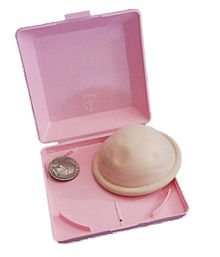

Contraceptives are devices, techniques and methods used to prevent human fertilization. Contraceptives are used for birth control purposes either to prevent fertilisation or to interrupt a pregnancy.
Barrier contraception attempts to prevent pregnancy by using devices to physically prevent sperm from entering the uterus. Devices in common use include condoms, female condoms, cervical caps, and diaphragms. SILCS diaphragms are still in clinical testing.
Hormonal contraceptives inhibit female fertility or ovulation. These include injectable[1] and oral contraceptives. The most common hormonal contraceptives are the combined oral contraceptive pill, commonly referred as "The Pill", which includes a combination of an estrogen and a progestin (progestogen), and the minipill that contains only synthetic progestogens and do not contain estrogen.
Contragestion occurs when an implanted device prevents or interrupts implantation of the embryo or causes the uterine lining to shed during the implantation period.[2][3] An intrauterine device (IUD) 'coil' with or without hormones or copper, is a contragestive device.
Emergency contraceptives, or the "morning-after pill", are drugs that disrupt ovulation or fertilization in order to prevent pregnancy taken after sexual intercourse. An IUD can also be usd as an emergency contraceptive, if it is implanted early enough.[4][5] [6] There are also hormonal emergency contraceptives.
Some regard an abortion, which is the removal or expulsion of a fetus or embryo from the uterus, to be a form of birth control.[7]

All contraception methods, other than the use of a condom, are applied by the female.